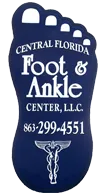Tendonitis
Tendonitis In Central Florida
Serving Winter Haven, Lakeland, & Davenport, FL
What is Tendonitis of the Foot?
When you use a set of muscles too much, you're likely to strain the tendons (soft tissues) that connect those muscles to your bones. At first, pain or swelling may come and go quickly. But if you do too much too soon, your muscles may overtire again. The strain may cause a tendon's outer covering to swell or small fibers in a tendon to pull apart. If you keep pushing your muscles, damage to the tendons adds up and tendonitis develops. Over time, pain and swelling may limit your activities. But with your doctor's help, tendonitis can be controlled. Both your symptoms and your risk of future problems can be reduced.
How a Tendon Functions
A tendon connects muscle to bone. The tendon stretches to accommodate the movement of your joints and muscles. If a tendon is stiff from inactivity and then suddenly is stretched beyond its limits, tendonitis, or in severe cases, a torn tendon, can be the result.
The Back of Your Foot
The Achilles tendon connects the calf muscle to the heel bone. If tendonitis occurs here, you may feel pain when your foot touches down or when your heel lifts off the ground.
The Front of Your Foot
The anterior tibial tendon helps control the front of your foot when it meets the ground. If this tendon is strained, you may feel pain when you go down stairs or walk or run on hills.
The Inside of Your Foot
The posterior tibial tendon runs along the inside of the ankle and foot. If this tendon is strained, your foot may hurt when it moves forward to push off the ground. Or you may feel pain when your heel shifts from side to side.
The Outside of Your Foot
The peroneal tendon wraps across the bottom of your foot, from the outside to the inside. Tendonitis here may cause pain when you stand or push off the ground.
Causes of Tendonitis
Tendonitis is caused by overuse or overstress of a tendon. One of the most common types of tendonitis is Achilles tendonitis, which can lead to ankle and heel pain. There are several factors that can increase your risk of developing tendonitis, including:
- Wearing the wrong shoes for the activity you are doing
- Not stretching your feet and legs enough before exercising
- Overdoing an activity, which can overstress your tendons
What You Can Do to Help with Tendonitis
There are several simple tips you can follow to ease the pain of tendonitis. Remember to:
- Do calf stretches several times each day
- Apply ice to your painful tendon several times daily
- Rest and elevate your foot to take the stress off your tendon
- Try to substitute low-impact activities whenever you can
- Try to stay on even, dry surfaces if possible
- Wear supportive footwear which is appropriate for what you are doing
Treating Tendonitis of the Foot
Your doctor's first concern is to reduce your symptoms. Using ice and heat, taking medications, and limiting activity help control pain and swelling. Follow all of your doctor's instructions. Returning to activity too soon may cause your symptoms to come back.
For moderate to severe tendonitis that doesn’t respond to home therapies, you should seek out the expertise of your foot and ankle specialist. Professional treatments your doctor may recommend include:
- Prescription anti-inflammatory medications
- Cortisone injections into the tendon
- Physical therapy and ultrasound treatment
- Assistive devices such as walking casts or boots
- Repairing the tendon surgically

Ice and Heat
Ice helps prevent swelling and reduce pain. Place ice on the painful area for 10 minutes. Repeat the icing several times a day. If you already have swelling using heat may help. Apply a heating pad or hot towels to the tendon for 30 minutes 2-3 times a day.
Medications
Your doctor may tell you to take aspirin or other anti-inflammatory medications. These reduce pain and swelling. Take them as directed. Don't wait until you feel pain. In more severe cases, cortisone may be injected to relieve pain.
Limiting Activities
Rest allows the tissues in your foot to heal. Stay off your feet for a few days, then slowly work back into activity. If you do high-impact activities, such as running or aerobics, try other activities that place less strain on your foot. Cycling and swimming are good choices.
